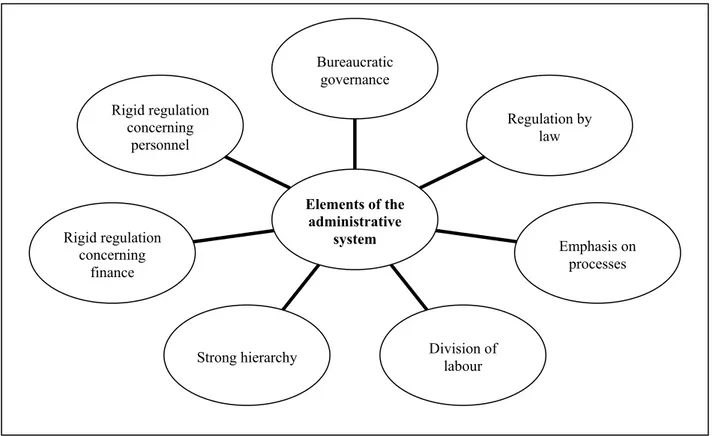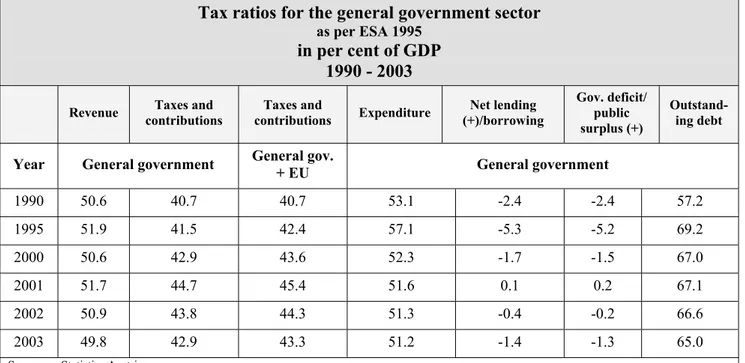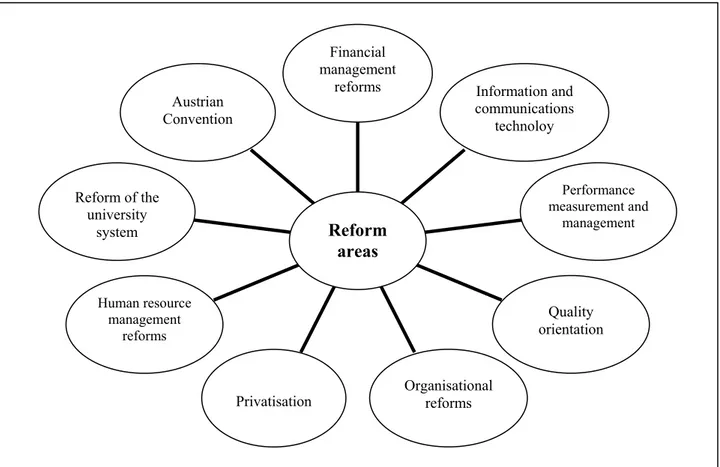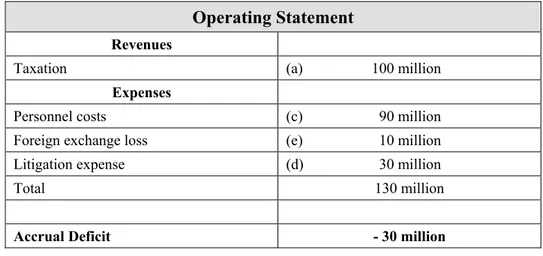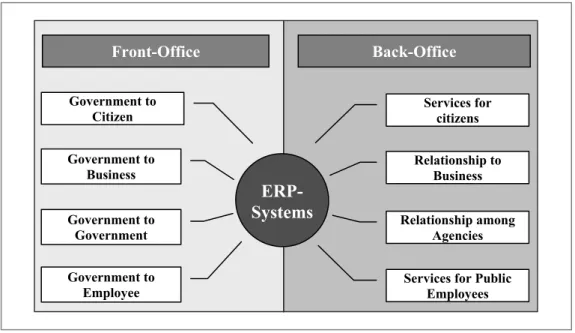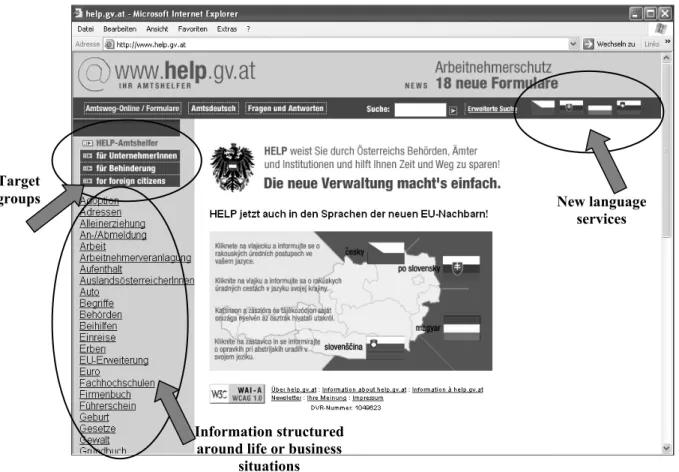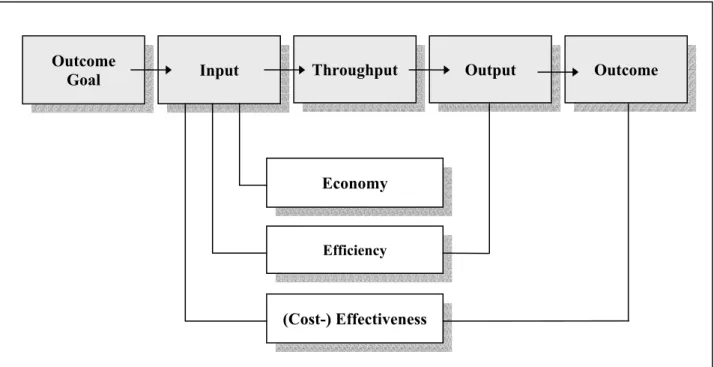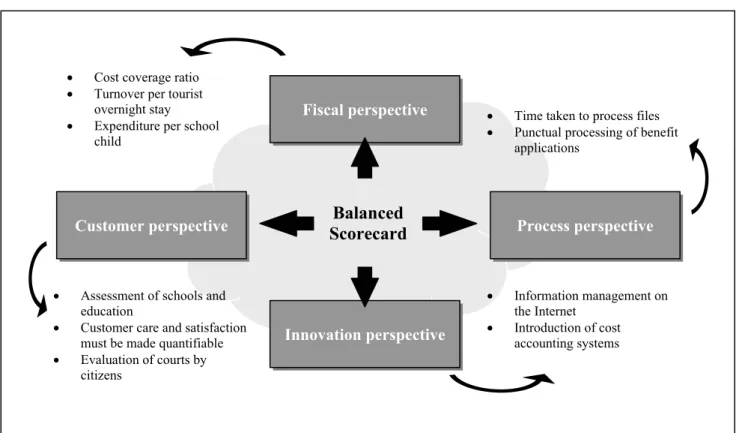WORKING PAPER 15/2004
Public Management Reforms in Austria
Kurt Promberger Iris Rauskala Franziska Cecon
University of Innsbruck European Academy Bolzano Centre for Public Management Institute of Public Management
Universitätsstrasse 15 Viale Druso 1
A-6020 Innsbruck I-39100 Bolzano
+43-512-507-7601 +39-0471-055-400 www.verwaltungsmanagement.at www.eurac.edu
verwaltungsmanagement@uibk.ac.at info4@eurac.edu
Table of Contents
Tables... III Figures... IV Abstract ...V
1 Introduction and Background... 1
1.1 State Structure and Constitutional Basis... 1
1.2 Administrative Structure... 3
1.3 Special Features of the Austrian Public Sector... 5
2 Public Management Reforms at the Federal Level... 10
2.1 Financial Management Reforms ... 13
2.1.1 Innovations in Financial Management... 14
2.1.1.1 Budget Reforms ... 14
2.1.1.2 Accounting Reforms ... 15
2.1.2 Status of Governmental Budgeting and Accounting in Austria... 18
2.1.2.1 Flexibility Clause Experiment ... 19
2.1.2.2 Cost and Performance Accounting ... 22
2.1.2.3 Future Reform Directions ... 24
2.2 Information and Communications Technology (ICT) ... 24
2.2.1 E–Government ... 25
2.2.1.1 The Austrian E-Government Act ... 26
2.2.1.2 Help.gv.at – the Virtual Guide on Austrian Authorities ... 27
2.2.2 Enterprise Resource Planning (ERP-) Systems ... 29
2.2.2.1 Concept of Enterprise Resource Planning ... 30
2.2.2.2 ERP in the Austrian Government – SAP R/3 ... 31
2.3 Performance Measurement and Management... 33
2.3.1 Federal Performance Report ... 36
2.3.2 Austrian Experience with the Balanced Scorecard ... 38
2.3.3 Interim Results ... 38
2.4 Quality Orientation ... 40
2.4.1 Speyer Quality Award... 43
2.4.2 Common Assessment Framework (CAF) ... 44
2.4.3 Mystery Shopping... 45
2.5 Organisational Reforms ... 46
2.5.1 Corporatisation in Austria... 48
2.5.2 Critique on Corporatisation/Off-Budget Companies ... 51
2.5.3 Examples of Organisational Reform... 52
2.6 Privatisation ... 58
2.6.1 Historically Determined Specifics in Austrian Public Sector... 61
2.6.2 Overview of Privatisation in Austria and Comparison with other Countries ... 63
2.6.3 Prospects of Privatisation in Austria... 65
2.7 Human Resource Management Reforms ... 66
2.7.1 From Personnel Administration to Personnel Management ... 67
2.7.2 Personnel System of the Austrian Federal Government ... 68
2.7.2.1 Legal Status of Public Officials ... 69
2.7.2.2 Recruitment... 69
2.7.2.3 Remuneration... 70
2.7.2.4 Career Development ... 71
2.7.2.5 Senior Executive Service ... 71
2.7.3 Future Reform Directions ... 74
2.8 Reform of the University System – A Case Study... 74
2.8.1 Starting Point of Reform in Austria ... 75
2.8.2 Elements of Reform ... 76
2.9 SUPPLEMENT: Performance Measurement: Intellectual Capital (IC) Reporting ... 79
2.10 Austrian Convention – A Parliamentarian Reform Initiative ... 82
2.11 Conclusions and Summary of Reforms at the Federal Level... 83
3 Public Management Reforms at the “Länder” Level ... 85
3.1 Steering ... 86
3.2 Structures ... 87
3.3 Processes ... 89
3.4 Organisation and Employees ... 92
3.5 External Relations... 93
3.6 Review of the Legal Basis ... 95
3.7 Fiscal Effects of NPM Reforms ... 95
3.8 Recommendations to the Provinces and Conclusions ... 96
4 Public Management Reforms at the Municipal Level ... 100
4.1 Main Topics of Municipal Reform ... 102
4.1.1 Output-Oriented Management ... 104
4.1.2 Service-Oriented Reorganisation ... 104
4.1.3 Cost and Performance Accounting ... 104
4.1.4 Benchmarking and Competitiveness between Municipalities ... 105
4.1.5 Co-operation between Municipalities ... 107
4.1.6 Quality Management – E-Government ... 110
4.1.7 Human Resource Management ... 115
4.2 Conclusions of Municipal Reforms ... 116
5 Bibliography... 117
6 Authors... 122
Tables
Table 1: Public sector employees at the federal, provincial and municipal level...6
Table 2: Government deficit and surplus (1990 - 2003)...7
Table 3: Tax ratio for the general government, 1990 - 2003 ...8
Table 4: Cash flow statement...16
Table 5: Operating statement ...17
Table 6: Balance sheet (financial position)...17
Table 7: Hived off agencies ...50
Table 8: Assets and capital of BIG ...53
Table 9: Privatisation of state-owned enterprises: global amount raised from privatisation...64
Table 10: Committees of the Austrian Convention and their review subjects...83
Table 11: Four reform patterns ...84
Table 12: Recommendations for provinces ...97
Table 13: Reform areas and their realisation in the provinces...98
Table 14: Use and envisioned use of NPM instruments in the provinces ...99
Table 15: Number and size of municipalities ...101
Table 16: Speyer Quality Award - participants and winners ...111
Table 17: Complaints management in Linz ...112
Table 18: Major themes of the E-Government Act...113
Figures
Figure 1: Austria's map and political division into provinces...1
Figure 2: Federal and provincial relationship ...3
Figure 3: Elements of the administrative system...4
Figure 4: Reform areas...13
Figure 5: E-Government and ERP ...25
Figure 6: User's surface of www.help.gv.at...27
Figure 7: Electronic Service Delivery...29
Figure 8: SAP R/3 and its modules...32
Figure 9: Input-Output-Outcome-Model (IOO-Model), 3 E's ...34
Figure 10: Balanced Scorecard in the public sector...35
Figure 11: Instruments and systems towards quality...41
Figure 12: The CAF Model...45
Figure 13: Four circles model of the public sector organisations ...47
Figure 14: New structure of the Austrian Federal Railways...57
Figure 15: Restructuring plan and its milestones...58
Figure 16: Types of privatisation...59
Figure 17: Problems of public sector, solutions and advantages ...60
Figure 18: Formal procedure for privatisation projects ...62
Figure 19: University Act 2002 ...78
Figure 20: Model for IC reporting of Austrian universities...80
Figure 21: NPM topics at the provincial level ...85
Figure 22: Municipal structure...100
Figure 23: Municipal management ...103
Figure 24: Human resource management ...115
Abstract
Public sector reform in Austria is a ‘never ending story’. Each new elected government is writing a new chapter in this incredible book. In more recent history, these chapters are representing different reform initiatives, which are labelled ‘public management project’ (1989 until 1993) or
‘administration innovation programme I and II” (1999 until now). In the mid 1990s the ‘new public management’ wave or revolution reached Austria. Politicians, top officials and political interest groups have been calling for the implementation of key NPM instruments via media reports, party platforms and government white papers. Public management reform reached a new level of attention after a fundamental political change in federal government from a centre-left to a centre- right coalition in the year 2000. A long lasting period of social-democratic involvement in federal government had ended. The new era gives impetus for further public sector renewal.
The structure of this paper follows public management reforms at all three levels of government. In chapter one there is a general introduction about the Austrian political-administrative system, highlighting special characteristics. Chapter two concentrates on federal reforms, focussing first on the general background to continue with details to the various reform fields, and finally ending with concluding remarks. Chapter three and four follow this structure on provincial and municipal level respectively.
1 Introduction and Background
1.1 State Structure and Constitutional Basis
Austria is a federal republic - see the map in Figure 1 – and a representative parliamentary democracy characterised by the separation of state power between the federation (Bund) and the provincial governments (Länder). Including the local level, there are three levels of government:
• 1 federal government (Bund);
• 9 provincial governments (Länder);
• 2,359 local authorities (Gemeinden)1.
Figure 1: Austria's map and political division into provinces
The federation, the provinces and the municipalities are legally autonomous and independent in fulfilling their constitutional defined tasks. Owing to the constitutionally based system of close intra-governmental relations the Austrian political system is called co-operative federalism. Co- operative federalism refers to legislation and execution of laws as well as to revenue-sharing. Its administrative structure can be characterised as polycentric.2 All sovereign power rests with the citizens, who indirectly exercise this power through the election of the National Assembly
1 Österreichischer Gemeindebund, Online in Internet URL: http://www.gemeindebund.at/, Download: September 14, 2004
2 Franz Fallend: Vielfältiger Föderalismus. Ausgewählte Föderationen im Vergleich, p. 18 Lower Austria Upper Austria
Styria
Carinthia Salzburg
Tyrol
Vorarl- berg
Vienna
Burgenland
(Nationalrat).3 It is responsible for legislation as well as control of the government. The Federal Assembly consists of representatives of provincial governments and is called the “Bundesrat”, representing the institution through which the provinces participate in the legislation of the federation. In contrast to the National Assembly, the Federal Assembly is not directly elected but consists of appointed members of the provincial governments or their delegates. An institution equivalent to the federal parliament can also be found in each province (Landtag) and local authority (Stadt- or Gemeinderat).
The head of the Austrian state is the federal president, who is directly elected by the citizens for a fixed term of six years. Re-election is permitted only once. All presidents of the Second Republic have acted in accordance with the non-party character of their position, although candidates for the presidency are nominated by the political parties. The federal president has no administrative authority. In practice, he can act only according to the proposals of the federal government but according to the constitution he would have farther reaching competences. His main duties include representing the Republic abroad, signing international agreements and appointing the federal government.
Each province has its own constitution, parliament and government. It is headed by the so-called
“Landeshauptmann”, who is the leader of the provincial government. Legislative and executive powers are distributed between the federation and the provinces by the federal constitution (see Figure 2). It lists the fields in which the federal parliament may legislate. Fields not mentioned by the constitution are considered to be the responsibility of the province’s parliament.
The 2,359 municipalities4 are administered by politicians who are directly elected mayors in six out of nine provinces. Otherwise, they are elected by and out of the municipal council. The municipalities have a long tradition. The right to govern their local affairs under their own responsibilities within the limits set by the law is guaranteed by the constitution (“Kommunale Selbstverwaltung”) and allows that local authorities may issue regulations, which represent substantive law and which are binding for their citizens as long as no statutes of the federation or the provinces oppose them.
3 Provisions are also made for other direct democracy procedures such as referenda, popular initiatives and election of the Federal President by universal suffrage.
4 Vienna is not only the federal capital, but also a province and a municipality.
The Federal Chancellery, Public Service in Austria, Online in Internet, URL:
http://bkacms.bka.gv.at/2004/4/23/pubserv.pdf, November 2003, Download: September 15, 2004, p. 5
Figure 2: Federal and provincial relationship
1.2 Administrative Structure
The Austrian administrative practice is characterised by a strong legalistic approach – the so called Rechtsstaat – with constitutional protection, both for tiers of government and civil servants. The constitutional foundations are not restricted to general principles like the German Basic Law, but regulate certain functions in detail. Therefore, the administrative system is characterised by bureaucratic governance. It is regulated by law, emphasising processes instead of output and outcomes. Moreover, it is dominated by a high degree of horizontal and vertical division of labour and by a strong hierarchy as well as rigid legislative regulations concerning finance and personnel.
The latter is finding its expression in lifelong tenure, little or no workplace mobility and promotion
9 Can call for a referendum to challenge legislation passed 9 Can hand in a petition 9 Can propose a change in the
Constitution using a popular initiative
Federal President
Provincial Parliament
Federal Council
18 members (1 Chancellor, 11 Ministers,
6 State Secretaries)
Federal Parliament
Federal National Assembly Assembly 62 members 183 members
Supervises activities of the Federal Council
Proposes drafts legislation to
Parliament
Municipal Council Provincial
Council
elect Provincial Council
Electorate Mayor
elect Provincial Parliament elect
Municipal Council
elect National Assembly
elect Federal President elect
Federal Assembly
elect Mayor in 3 out of 9 provinces
appoints
elect Mayor in 6 out of 9 provinces
Austrian citizens from the age of 18
based on seniority. These features of the Austrian administrative system are depicted in the following figure.
Figure 3: Elements of the administrative system
At the federal level, the ministries5 and the authorities subordinated to them are entrusted with the conduct of all businesses on behalf of the federal administration. The powers and responsibilities of the individual federal ministries are clearly defined in the Federal Ministries Act. This act also contains provisions governing the organisational structure of the ministries and their rules of procedure.6 The tasks of the federal administration are either performed directly by federal authorities or indirectly by province authorities.
At the provincial level the head of provincial government and his members (Landesräte) determine the general policy of their province. In general, the federal level and the provinces are independent of each other in their financial and budgetary management. If the provinces act as agents of the federal government, the federation bears (almost all) expenditure incurred.7 For their own sphere of activities and for activities performed on behalf of the federal government, the provinces set up their own budgets, but they have to ensure that their fiscal administration meets the needs of the overall
5 For a complete list of the current federal ministries see The Federal Chancellery, Federal Ministries, Online in Internet, URL: http://www.bka.gv.at/DesktopDefault.aspx?TabID=3541&Alias=english, Download: September 16, 2004.
6 The federal ministries are subdivided into directorates-general, divisions, directorates and units.
7 This system results in a substantial influence of federal government on the provinces and in a twofold system with a considerable amount of parallel structures and overlapping between the two levels.
Rigid regulation concerning
personnel
Rigid regulation concerning
finance
Strong hierarchy Division of labour
Emphasis on processes Regulation by
law Bureaucratic
governance
Elements of the administrative
system
economic balance. They receive revenues from separate taxes of their own as well as from tax sharing between the federal level and the provinces.
In administering the provincial policies, the members of the governments are assisted by province government offices. In total, 84 district authorities are subordinated to the province authorities.
They are responsible for performing administrative functions on behalf of the province and of the federal government.
Besides the federal and the provincial governments, the municipalities carry out administrative tasks. Therefore, the mayor and the municipal council are supported by professional officers. In order to finance activities in their own sphere, at least partly, municipalities have to be able to levy their own revenues. Furthermore, they gain subsidies from the provinces and from the tax and fiscal equalization system between the provinces and the municipalities.
1.3 Special Features of the Austrian Public Sector
Austria is characterised by a large public sector with a general government employment8 as a percentage of total employment above the OECD average.9
Table 1 shows civil servants, contract staff and other public employees according to the three administrative levels for the years 2001 and 2002. By the end of 2002, the Austrian public sector had a bit more than 490,000 employees, of which 39 % belonged to federal government, 29.6 % to provincial government, 14.2 % to Vienna and 16.4 % to municipal government.
8 General government employment means persons with employment regulated by public law.
9 Statistik Austria, Statistisches Jahrbuch 2004, Online in Internet, URL: http://www.statistik.at/cgi- bin/jahrbuch.pl?KAPITEL=07&SPRACHE=D, Download: September 15, 2004
Public Sector employees at the federal, provincial and municipal level
Federal government employees in 2001 and 2002
Active employees 2001 2002
Civil servants 149,275 138,264
Contract staff 56,269 55,399
Other 1,670 1,263
Total 207,214 194927
Employees of the provincial governments
Active employees 2001 2002
Civil servants 47,211 46,129
Contract staff 92,672 93,871
Teachers 7,5415 74,758
Total 215,298 214,758
Table 1: Public sector employees at the federal, provincial and municipal level
Furthermore, the Austrian public sector shows intense legal regulations, a hierarchical administrative culture rooting in the ancient monarchy, and a complex federal system. To understand the reform dynamic, it is important to get the picture of so-called “indirect federal administration”, a complex inter-relationship between the federal government and the provinces dating back to the days of the monarchy, too. This multi-level system has been subject of ongoing discussion during the last two decades. Most recent, the “Austrian Convention” (see 2.10) is trying to find a new state architecture, although the mutual legislative setting of the federation and the provinces makes far reaching changes a tedious process.10
Traditionally, the Austrian system has shown unique and in its intensity distinctive features:
• an unusually stable two party government (centre-left, “grand coalition” between the conservative People’s Party and the Social Democrats)
• the overriding principle of the so called “Social Partnership”11 as a strong social and political stabilisation factor, known as neo-corporatism as well as
• the so called “Proporz system”, which means that the major political, administrative and economic functions are distributed according to political strengths of the parties. Most positive effect of this proportional representation has been the political stability and governability of the country. Compromise, mutual concessions and consensus among the elites have determined the political culture.
Due to these characteristics, Austria has been part of the “maintainers” concerning reform efforts12 and until recently, was lagging behind the international new public management developments.
10 By constitution, the change of central areas requires a qualified majority (2/3) in the federal parliament and the approval of each of the nine provincial governments.
11 Though there is no constitutional or legal basis for it, the social partnership plays a decisive role in translating interests of employers and employees into policies. It is supported by the party system as many of their leaders are also members of parliament and occupy important party functions.
12 Pollitt Christopher/Bouckaert Geert, Public Management Reform, A Comparative Analysis, 2nd edition, Oxford University Press, Oxford, 2004, pp. 98 f.
Employees of the local governments (without Vienna)
Active employees 2001 2002
Civil servants 10,382 10,206
Contract staff 63,740 63,537
Other 6,753 6,625
Total 80,875 80,368
Public Sector Employees in Total 503,387 490,053
Source: Statistics Austria, adapted from the Statistical Yearbook 2004
Notes: Federal level: Civil servants include civil servants of the Post AG/UB Post und Postauto, Telekom Austria AG, PTI and GIS;
Provincial level: Provinces including Vienna excluding Wiener Stadtwerke and Wiener Wohnen;
Municipal level: Municipalities excluding Vienna and association of municipalities.
However, the joining of the European Union in 1995 had significant influence on the political and economic environment – though not resulting in major changes of organisational structures; it still put considerable pressure on the need for severe budget consolidation programmes and structural adjustments. This was and still is especially true for the federation, while provinces and most municipalities show small surpluses.13 The development of public deficit in the various government levels is shown in Table 2.
Government deficit(-)/public surplus(+)
as per ESA 1995
1990 - 2003
Year General government
Central government
Provincial
Government Municipalities Social security funds
1990 -2.43 -3.39 0.84 0.31 -0.19
1995 -5.16 -4.71 0.09 -0.49 -0.06
2000 -1.49 -1.63 0.21 0.04 -0.11
2001 0.25 -0.52 0.52 0.26 -0.01
2002 -0.21 -0.87 0.42 0.25 -0.02
2003 -1.28 -1.77 0.31 0.19 0.00
Source: Statistics Austria
Notes: No compensation of rounding differences.
Federal sector: Federal government, federal funds, federal chambers Provincial level: Länder excluding Vienna, Land funds, Land chambers
Municipality level: Municipalities including Vienna, municipality funds, association of local governments
Table 2: Government deficit and surplus (1990 - 2003)
Not only government deficits and debt have been a problem in the past, but also the tax ratio has been much too high14 in the international context and in comparison to the EU average. For this
13 Contributions of central and local governments to public deficit show that, in 2003, Federal Government reported a deficit of € 3.9 billion or 1.7 % of GDP, the highest such figure since 1999 (€ 4.8 billion or 2.41 % of GDP). Together, the nine federal provinces recorded a surplus of 0.49 % of GDP last year, at € 1.1 billion; this was the lowest such figure since 2000. The accounts rendered by municipalities and other public legal entities (social insurances, chambers and funds) have been relatively balanced since 1998 (between – 0.1 and + 0.1 % of GDP).
Statistik Austria, Public Finances, Online in Internet, URL: http://www.statitisk.at/englisch/results/vgr/
finances_txt.shtml, Download: September 15, 2004
14 Government expenditure in 2003 amounted to € 114.7 billion (51.2 % of GDP), government revenue to € 111.5 billion (49.8 % of GDP), resulting in a negative financing balance of € - 3.2 billion (- 1.4 % of GDP). Compared with 2002, the balance increased by € 2.3 billion or 1.0 % of GDP. This rise is due almost exclusively to a decrease in the government revenue quota (- 1.1 per cent of GDP). Charges, i.e. production charges, income and property taxes, asset-effective taxes and actual social contributions, accounted for 86 % - or € 96.0 billion – of government revenue (€ 111.5 billion) in 2003. The most significant changes over the past few years were registered in income and property taxes:
2000: € 27.4 billion (13.3 % of GDP) 2001: € 32.0 billion (15.1 % of GDP) 2002: € 305.0 billion (14.0 % of GDP) 2003: € 29.7 billion (13.0 % of GDP)
Statistik Austria, Public Finances, Online in Internet, URL: http://www.statistik.at/englisch/results/vgr/
finances_txt.shtml, Download: September 15, 2004
reason, down-sizing programmes have been popular. This will be further illustrated in 2.5 and 2.6, where the Austrian actions towards organisational reform and privatisation are being discussed.
Table 3 gives an overview of the development of the contribution of taxes to general government funding.
Tax ratios for the general government sector
as per ESA 1995
in per cent of GDP 1990 - 2003
Revenue Taxes and
contributions Taxes and
contributions Expenditure Net lending (+)/borrowing
Gov. deficit/
public surplus (+)
Outstand- ing debt Year General government General gov.
+ EU General government
1990 50.6 40.7 40.7 53.1 -2.4 -2.4 57.2
1995 51.9 41.5 42.4 57.1 -5.3 -5.2 69.2
2000 50.6 42.9 43.6 52.3 -1.7 -1.5 67.0
2001 51.7 44.7 45.4 51.6 0.1 0.2 67.1
2002 50.9 43.8 44.3 51.3 -0.4 -0.2 66.6
2003 49.8 42.9 43.3 51.2 -1.4 -1.3 65.0
Source: Statistics Austria
Notes: Part of the taxes levied by the general government (in particular value added tax) are own resources of EU institutions.
Situation as of April 1, 2004
Table 3: Tax ratio for the general government, 1990 - 2003
Financial pressures as well as political change have been starting points for comprehensive reform.15 This can be documented with increasing competition between the political parties and diminishing role of the social partnership as a mediator. In 2000, these developments were further spurred by the incoming centre-right coalition which can be seen as a break with the politics of the past years. Being re-elected in 2003, there was a shift within the coalition from the right to the centre, but in fact there was no return to the former centre-left coalition in spite of greater political upheavals.
The term “New Public Management” has only slowly been adopted in Austria. Reasons may be difficulties in transporting the complex concept together with Anglicism. Therefore, the Administrative Innovation Programme at the federal level used the term “Wirkungsorientierte Verwaltungsführung” (outcome-oriented government) of the Swiss public sector modernisation
15 Supported by international experience, it is generally agreed upon that fundamental political change is a main factor driving administrative reform.
For the Austrian context: Dearing Elisabeth, New Public Management in der österreichischen Bundesverwaltung, in: Bauer Helfried/Biwald Peter/Dearing Elisabeth (eds.), Öffentliches Management in Österreich, Realisierungen und Perspektiven, KDZ, Wien, 2003, p. 83
programme to overcome language barriers.16 The provinces, too, named their reforms rather according to terms of existing programmes in the German-speaking countries than taking hold of English terminology, though gearing their reform concepts on the themes of NPM (customer and citizen-orientation, output-orientation, quality-orientation and competition).
Although Austria has been slow towards public management reforms there are considerable initiatives, especially since the 1990s. Starting with chapter 2 the reform initiatives of the last years shall be examined at the federal level, followed by provincial reforms in chapter 3 and the municipal reform agenda in chapter 4.
16 Dearing Elisabeth, New Public Management in der österreichischen Bundesverwaltung, in: Bauer Helfried/Biwald Peter/Dearing Elisabeth (eds.), Öffentliches Management in Österreich, Realisierungen und Perspektiven, KDZ, Wien, 2003, p. 83
2 Public Management Reforms at the Federal Level
Since 1997, two main reform programmes have shaped the public administration at the federal level: the Administrative Innovation Programme I (Verwaltungsinnovationsprogramm, short: VIP) and the Administrative Innovation Programme II. On December 3, 1997, the Administrative Innovation Programme I was launched and scheduled until June 1999. It was based on a holistic approach, relying on the involvement of both politicians and as many staff members from the administration as possible, covering all ministerial departments. The aims outlined in the programme demonstrated that the theoretical and practical debate at the international level on “New Public Management” in New Zealand, “Outcome-oriented Government” in Switzerland, as well as the “New Steering Model” in Germany, have influenced the reform objectives in Austria (though the term itself stems from initiatives in German-speaking countries17).
(1) Reorientation of the role of the state from a regulator to a modern service provider Citizen-orientation should not be interpreted as an end in itself, but in the sense that the services needed or required are provided in a way which perfectly satisfies the citizen’s needs.
VIP was the first to initiate projects with direct benefit for the public at large. Examples are one-stop agencies (e.g. District Police in Liesing, Vienna) or the virtual guide on public authorities at www.help.gv.at.
(2) Annual productivity gains of 2 – 3 % in the administration
In spite of the widening scope of services provided by the public administration and a steady decrease in staffing numbers, public servants have been able to maintain the quality and quantity of services. They have been supported by modern technology as well as by modern management tools such as cost accounting, performance indicators and management control.
Federal staffing levels have significantly declined since 1996.
(3) Gradual introduction of output-oriented governance
Output-oriented government includes management by objectives (MbO)18 and performance agreements, product catalogues, transparency of costs and services, as well as decentralised
17 Dearing Elisabeth, New Public Management in der österreichischen Bundesverwaltung, in: Bauer Helfried/Biwald Peter/Dearing Elisabeth (eds.), Öffentliches Management in Österreich, Realisierungen und Perspektiven, KDZ, Wien, 2003, p. 83
18 MbO and decentralised accountability for resources has been achieved, e.g. through the corporatisation of the federal theatres, the federal sports centres, or the federal environmental agency, and the introduction of the flexibility clause. Encouraged by the Swiss and German examples, the flexibility clause was incorporated into the Federal Budget Act after only 10 months of preparation. Starting in a pilot project, it empowers selected government departments to use allocated resources on the basis of performance agreements. Concomitant
accountability for resources. Starting to develop performance indicators has contributed significantly to make government services more transparent. As a result, the first performance report of the federal administration was published in October 1998.19
Another crucial prerequisite for an efficient and effective management of public services is the definition of products and required quality standards. Important steps towards the introduction of a product catalogue and higher cost transparency by reviewing the scope of action had been made. This created the basis necessary for further reform steps, like the introduction of business-like accounting systems. Progress in the field of developing cost accounting in the federal administration led to higher cost transparency in some administrative units until the end of VIP I.
(4) Introduction of efficient human resource management
For the federal administration as a large-scale organisation it is crucial to handle employees professionally.20 In the course of administrative reform, a large number of measures and instruments have been implemented, like the need to change administrative culture and to move employees towards results-orientation. With the participation and contributions of ministries and public service unions, the "Mission Statement for the Austrian Federal Service"
was developed within six months. Performance-related payment schemes will follow. Higher salaries at the start of a public service career shall ensure fairer and more equitable pay scales and, eventually, bring down the number of civil servants with permanent tenure.
For the objectives laid down by resolution of the Council of Ministers on December 3, 1997 the outcome was encouraging and advantageous for a continuation of the reform directions. Thus, subsequently to the Administrative Innovation Programme I, the Council of Ministers initiated a new phase of the Administration Innovation Programme (VIP II)21 on July 8, 2003. VIP II seeks to realise around 80 projects. A database on the internet shall help to evaluate the progress being
management control ensures that the ministry or the Federal Ministry of Finance retain their role in giving strategic direction.
19 Interested readers will learn that, by international comparison, the number of major crimes and offences committed, such as theft, robbery, or homicide is far lower in Austria than in Switzerland and Germany, or that the numbers of police summonses and the number of driving licences being withdrawn on account of drunken driving have been constantly declining since 1993.
20 That means that staff is employed according to demand and requirements needed, that a certain degree of confidence and pride in their role and activities is instilled in them, that consistency and continuity in the accomplishment of tasks is being ensured and that adequate performance-related pay is being offered.
21 The programme is organised by the VIP Advisory Council, which consists of representatives of the ministerial departments. It acts as an interface to political decision-makers. The representatives are responsible for the progress of the individual projects within their sphere of competence in the respective ministries and administrative units.
made.22 VIP seeks to attain the objectives of more efficiency and citizen-orientation in conducting administrative action, securing Austria’s position as a business location and achieving further spending cuts amounting to a total of € 1.3 billion by 2006 with an elimination of 10,000 full-time equivalents between 2003 and 2006. In pursuing these objectives, VIP II focuses on the following activities:
• Combined responsibilities for resources and outcomes: Implementation of global budgets, development of a performance indicator system, and federal cost accounting.
• E-government initiative: Expansion of e-government to new areas, drafting a bill on e- government, ongoing external relations activities, etc.
• Organisational reforms: Setting up a central accounting agency, merging the local and federal police, corporatisation of the state universities, etc.
• Quality management: Enforcement of quality tests like “mystery shopping” for public authorities, more widespread use of the Common Assessment Framework (self-assessment system), etc.
• Continuation of other administrative reform projects: Introduction of SAP and electronic files throughout the federal administration and Flexibility Clause (Experimentation Clause)23
Following this general introduction to Austrian federal reform initiatives, further details will be provided in the upcoming sections. Embedded as well in an international context the Austrian reforms are presented, described and if possible evaluated. Though, a final evaluation is not possible in every case and therefore it may reflect interim results. Figure 4 illustrates the main reform fields in discussion.
22 Dearing Elisabeth, New Public Management in der österreichischen Bundesverwaltung, in: Bauer Helfried/Biwald Peter/Dearing Elisabeth (eds.), Öffentliches Management in Österreich, Realisierungen und Perspektiven, KDZ, Wien, 2003, p. 84
23 The Federal Chancellery, Public Service in Austria, Online in Internet, URL:
http://bkacms.bka.gv.at/2004/4/23/pubserv.pdf, November 2003, Download: September 15, 2004, p. 23
Figure 4: Reform areas
2.1 Financial Management Reforms
Many governments have reformed their public sector arrangements in recent years. In contrast to the traditional focus on inputs a concentration on outcomes is noticeable. At the same time, they are seeking greater efficiency and better fiscal performance. Public debt, budget deficits and interest payments in the federal budget reached a critical level in reference to the convergence criteria of the Treaty of Maastricht (a government budget deficit not in excess of 3 % of each country’s GDP; a gross dept to GDP ratio that does not exceed 60 %). The level of debt is an unacceptable burden to future generations. This induces discussions about the budgeting and accounting system in the public sector and approaches to strengthen cost consciousness. To improve effectiveness, efficiency and economy the accounting system has to produce detailed information of outputs, costs, assets and debt alongside revenues und expenditures. More and more, the traditional input-oriented, cash based or compliance-oriented system was compared to the system of commercial (accrual) accounting. Results, outputs, costs and accrual accounting became keywords within the discussions and the demand for a reform of the budgeting and accounting system.24
24 Chan James L., Changing roles of public financial management, in: Bovaird Tony/Löffler Elke (eds.), Public Management and Governance, Routledge, London, 2003, pp. 101 ff.
Austrian Convention
Reform of the university
system
Human resource management
reforms
Privatisation Organisational reforms
Quality orientation
Performance measurement and
management Information and
communications technoloy Financial
management reforms
Reform areas
2.1.1 Innovations in Financial Management
Generally speaking, financial management reforms encompass reforms of the budgeting system (content, structure, process) and reforms of the accounting (accounts, documents) system.25
2.1.1.1 Budget Reforms
Two particular external pressures are the driving forces of budget reforms. The first is the restraint of growing public expenditure. The second is the performance improvement (greater efficiency or effectiveness or higher quality) within the public sector. The reforms that have served the savings objective do not always fit well the reforms that are required to encourage performance improvements. The initial reaction of some governments to financial pressures was the strengthening of central finance ministries to cut back programmes in a top down approach. To adopt or increase the use of frame or block budgeting – which is more compatible with performance improvement – is another option to reach the demanded savings. Here, the central ministry sets broad ceilings (frames), but within those, it delegates responsibility for allocation to particular services, programmes, or projects to politicians and/or managers. Frame-budgeting requires some redesign of budgetary procedures. There need to be clear and separate phases of the budgetary discussion – first, the determination of aggregate financial frames (and therefore a debate about what the modest appropriate formulas should be) and second, a detailed discussion of allocations attributed to specific programmes (and how performances of those programmes should be measured). Budget reforms that are more related to performance rather than savings, contain the following elements:
(1) Publication of performance information alongside the annual budget documents
(2) Change of the format and contents of the budget itself, typically by moving away from line item budgeting towards a more performance-sensitive type of categorization or by trying to link up budgeting with new processes of strategic planning
(3) Change of the procedure of budgeting by altering the incentives to key budget actors or by fundamentally changing the structure or timing of the budget discussion, or even by attempting to alter the role of the legislature in the budgeting process.
25 Pollitt Christopher/Bouckaert Geert, Public Management Reform, A Comparative Analysis, 2nd edition, Oxford University Press, Oxford, 2004, pp. 6 f.
Hughes Owen E., Public Management and Administration, An Introduction, 3rd edition, Palgrave Macmillan, New York, 2003, pp. 165 ff.
2.1.1.2 Accounting Reforms
The second aspect of financial management reform is the modernisation of accounting systems.26 The public and the private sector both used cash accounting until the 16th century. While government accounting remained on a cash basis, the private sector developed generally accepted accounting principles (GAAP) including accrual accounting. Cash accounting records receipts when cash is banked and payments when cash is paid. Accrual accounting recognizes events and transactions when they occur, regardless of when cash changes hands. International accounting standards (IAS) require the preparation of four key statements:
(1) Statement of fiscal position (balance sheet)
(2) Statement of fiscal performance (operating statement, income statement or profit and loss account)
(3) Statement of changes in net assets/equity) and (4) Cash flow statement.
Government accounting systems determine how financial and statistical information is prepared and presented.27 To varying extents, most OECD member countries have implemented accrual accounting in the past decade. But, only four OECD member countries (Australia, Finland, Iceland and New Zealand) have implemented accrual budgeting (appropriate resources on the accrual basis). Implementing accrual appropriations generally requires fundamental legal changes and the application of computerized accounting information system.
26 Lüder Klaus/Jones Rowan, The diffusion of accrual accounting and budgeting in European governments – a cross-country analysis, in: Klaus/Jones Rowan (eds.), Reforming governmental accounting and budgeting in Europe, Fachverlag Moderne Wirtschaft, Frankfurt am Main, 2004
27 The three major international systems have slightly different purposes:
The European Union (EU), International Monetary Fund (IMF), OECD, United Nations (UN) and World Bank jointly publish the System of National Accounts (SNA). It compiles aggregate financial statistics for an entire economy (government and private sector activities are combined together).
The IMF Government Finance Statistics (GFS) is a specialized system intended to support public sector analysis. The IMF designed GFS so that government financial information could be compared across economies.
The International Federation of Accountants (IFAC) began promulgating International Public Sector Accounting Standards (IPSAS) in 2000. They are designed for use in the preparation of general purpose financial reports by public sector entities (individual government agencies or whole-of-government reports).
SNA, GFS and IPSAS have been developed in the past decade and all are accrual based. The European System of Accounts (ESA 95) also mandates accrual –based financial reporting. IPSAS are based on the private sector International Accounting Standards (IAS). IFAC has issued 20 accrual-based IPSAS. By now only few countries directly referred to IPSAS for their public sector reporting. However, there is a trend for countries to refer to IPSAS when developing government accounting standards. Several international organisations have decided to implement the accrual-based IPSAS (e.g., European Commission, OECD).
An example
To illustrate the difference between cash and accrual accounting an example is provided.28 It considers a week in the life of a small government unit. The effects of the following five transactions are shown in the financial statements below:
(a) Corporate taxpayers are required to make tax payments of € 100 million to the government, but only € 90 million is received. At the end of the week, € 10 million is outstanding.
(b) The government sells fixed assets for € 100 million. The assets had been valued at € 100 million.
(c) Government salary payments are made during the week. In addition to paying € 60 million, the government is obligated to provide for their pensions when they retire – employees earned
€ 30 million in future pension rights during the period.
(d) The government settles a long-running legal dispute. It agrees to pay € 30 million to the plaintiff in two month time.
(e) All the government’s borrowings are held in foreign exchange. The exchange rate declined by two percent during the week.
As Table 4: Cash flow statement shows, cash accounting would report a € 130 million surplus, which reflects the traditional administrative way of bookkeeping (cash accounting).
Cash Flow Statement
Receipts
Taxation (a) 90 million
Asset sales (b) 100 million
Payments
Salaries (c) - 60 million
Cash Surplus 130 million
Bank balance
Opening 50 million
Closing 180 million
Table 4: Cash flow statement
The accrual operating statement (Table 5) – as used in private sector business - shows a € 30 million deficit. Operational statement s and balance sheets are prepared additionally to a cash flow statement under the accrual accounting regime.
28 Athukorala Lakshman S./Reid Barry, Accrual Budgeting and Accounting in Government and its Relevance for Developing Member Countries, Asian Development Bank, 2003, Online in Internet, URL:
http://www.adb.org/Documents/Reports/Accrual_Budgeting_Accounting/chap02.pdf, Download: September 13, 2004
Operating Statement
Revenues
Taxation (a) 100 million
Expenses
Personnel costs (c) 90 million
Foreign exchange loss (e) 10 million
Litigation expense (d) 30 million
Total 130 million
Accrual Deficit - 30 million
Table 5: Operating statement
The actual difference between the cash flow statement and the operating statement amounts to € 160 million. This difference arises from the fact that cash accounting ignores the pension liability (€
30 million), the asset already has a value equal to its sale price (€ 100 million), the exchange rate change (€ 10 million), the judgement liability (€ 30 million), and the taxes to be received (€ 10 million), as shown in Table 6.
Balance Sheet
Opening Changes Closing
Assets
Bank 50 130 180
Receivables 20 (a) 10 30
Fixed assets 700 (b) 100 600
770 40 810 Liabilities
Litigation (d) 30 30
Pension liability (c) 30 30
Borrowings 500 (e) 10 510
500 70 570
Net Assets 270 - 30 240
Equity and Reserves 270 - 30 240
Table 6: Balance sheet (financial position)
2.1.2 Status of Governmental Budgeting and Accounting in Austria
Governmental budgeting and accounting at the federal level is input-oriented, cash based. The legal framework of budgeting and accounting is a hierarchical system comprising different regulations.29 Despite the apparent simplicity of cash accounting, budgeting and accounting documents are not easy to understand because receipts and payments are reported in great detail. As a result, current budgeting and accounting lack transparency. Cash budgeting and accounting are primarily aimed to meet the budgetary control needs of the parliament and it is limited to the core sector of the government.30 In contrast to the core public sector, public spin-offs31, as part of the peripheral sector of government, are using commercial accounting systems: double-entry bookkeeping, a comprehensive balance sheet, a profit and loss statement, a cash flow statement, global budgets (net budgets) as well as a cost accounting system. These became the technical basis of the financial management of these legally independent, still government-owned public entities. As a consequence, the peripheral sector of the Austrian federal administration cannot be integrated in and consolidated with the core public sector managed by traditional budgeting and accounting system.
Therefore, it is impossible to produce consolidated information on a government’s overall financial position, total assets and debts. The only way to solve this problem and to develop a consolidated system for the “two different worlds of accounting and management” is to change the cash based and input-oriented accounting system of the core sector to the accrual based accounting of the peripheral sector. The problem of providing useful aggregated financial information becomes more important with the increasing significance of the peripheral sector.
The key player of the budgeting and accounting reform at the federal level is the Minister of Finance. The vast majority of the staff of this ministry prefers – if at all – a very cautious piecemeal change of the actual budgeting and accounting system. Piecemeal change refers to a reform, characterised by more flexibility in running the budget, and additional information in comparison to the traditional budgeting and accounting system. The present cash based budget becomes more flexible by the possibility to transfer funds between budget items and into the next fiscal year.
Moreover, the present status is ‘optimized and extended’ by additional cost and performance information for all core government entities or just for selected organisations within the core administration of a ministry. However, presently this supplementary information is not integrated into a new concept of governmental budgeting and accounting. The information is at present only
29 It is regulated by law and not by any government external standard setting body (such bodies, even in the form of advisory bodies to the government on matters of public sector accounting, do not exist in Austria).
30 This includes especially federal ministries, as well as all administrative units subordinated to the ministries and superior authorities like the accounting office, constitutional court, administrative court and so on.
31 Due to public spin-offs the number of off-budget governmental units is increasing.
added to the existing system. The shift of international and European finance statistics from cash to accrual basis puts additional pressure on government to change their accounting system to accrual- based accounting.
2.1.2.1 Flexibility Clause Experiment
Government budgeting and accounting reform in Austria is inconceivable without amendments of the legal framework. Therefore in 199932, the Federal Budget Act was reformed to improve flexibility and efficiency in preparing as well as executing the budget and to strengthen cost consciousness. This amendment (called Flexibility Clause) gives selected government agencies more discretion to move funds between budget items and to transfer unused funds into the next fiscal year. Without a doubt this is a first step towards introducing global budgeting within the Austrian budget framework. The Flexibility Clause was originally introduced for a period of three years. Meanwhile this project – as part of the Administration Innovation Programme of the federal government – has been extended until 2006. The legal basis for this programme is found in the §§
17a and 17b Federal Budget Act, which both represent constitutional law. In general, the Flexibility Clause represents an approach to introduce core elements of the New Public Management in the Austrian federal administration.
The Flexibility Clause (FC) can be characterised as follows:
• Administrative units participating in the FC initiative are able to manage their cash flow by utilising excess revenues in future financial years, as long as the mutually agreed difference between revenues and expenditures is not exceeded.
• The role of managers in FC agencies is significantly strengthened. They are permitted to incur non scheduled expenditures and make allocations to and from reserve funds, i.e. for further education and training purposes.
• According to the principles of global budgeting, the FC allows free movement of financial resources without the need for central government approval as long as the agreed amounts are not exceeded.
• The FC facilitates the management of additional funds which can be used for investments or for further education and training purposes.
• During implementation of the FC, agencies are subject to scrutiny through the responsible ministry and the ministry of finance.
32 OECD, PUMA, Recent public management initiatives in Austria, August 2000, Online in Internet, URL:
http://www1.oecd.org/puma/focus/compend/at.htm#Experimentation%20clause, Download: August 24, 2004
• To receive FC status, the applying administration unit needs the approval of the responsible ministry, the Ministry of Finance and the Federal Chancellery.
The FC allows more flexibility in the timing of the use of financial resources, within subordinated public agencies. On the basis of so called “performance contracts” a global amount of financial resources is assigned to a government entity for the delivery of specified outputs (goods and/or services) and outcomes. The underlying context of performance contracts is the link between inputs and results in the administration, which should help to establish a more result-oriented public sector.
The FC is an alternative to outsourcing and corporatisation (public spin-off) and encourages the development of a management culture.
Governmental entities running under the flexibility clause remain within the federal budget framework. The operational steering of FC organisations is based on the requirement to define and measure against a set of agreed management and performance controls. FC organisations are furthermore subject to quarterly reporting comparing the actual and expected performance concerning the revenues, expenditures and personal capacities. In contrast to the decentralisation of financial resources, human resources have not been decentralised which is limiting the flexibility of the FC organisations in a substantial way. The management of participating agencies have experienced this to be the main problem with this otherwise successful project.
The following principles of the Austrian budgeting system are affected through the FC:
• Structure of the budget
The Austrian budget is structured in detail and includes a range of principles, which prevents the shifting of resources according to actual requirements. The global budgeting of the FC allows the bypassing of this system at the level of the participating subordinated organisations.
• Focus on expenditures
Usually the focus in administrations lies on the expenditures, while the revenues are playing an insignificant role in the delivery of public services. The FC organisations have the possibility to increase their savings or at least to maintain their difference amount either the traditional way by saving costs or by increasing their revenues.
• Non-assignment of revenues
The total of all additional revenues generated by government entities belong to the ministry of finance and are managed centrally. Because of this principle there is little incentive in the administration to obtain additional revenues. In the FC, additional revenues remain, to a large extent, in the organisation which has obtained those revenues and they can be used either for
investments, reserve funds or education and training. This is a substantial motivating factor, which leads to an increase in the quality and efficiency of public sector management.
• Annuality principle
Since the Austrian budget is restricted to an annual cycle, possible savings of organisations expire by the end of the year, which leads to the well known “December fever” where money is spent just to retain the budget for the next year. The FC permits the transferring of additional funds into the next year, which allows the accumulation of funds for large scale investments.
Government entities applying for FC status have to meet at least the following minimal requirements:
• Consent within the organisation
• Obligatory commitment of employees
• Operational agency at the interface to the citizen
• Independent task spectrum providing the possibility to obtain revenues in different business segments
• Management tools (cost accounting, controlling, performance indicators etc.)
• Structural adjustments within the agency
In order to implement the FC according to its legal basis, administrative units have to consider the following obligatory checklist:
• Definition of strategic goals and core competencies
• Definition of particular objectives which should be achieved within the FC
• Definition of products as an basis for an output-oriented budget
• Implementation of a management control system based on performance indicators and performance reporting (including cost accounting)
• Performance contracting
• Determination and depiction of revenues, expenditures and permanent posts
In the year 2003, ten agencies with a total of 898 permanent posts have Flexibility Clause status (Federal Agency for Water Management, Federal Institute for Adult Education, Security Academy, Federal Law Office, Penitentiary Leoben, Sonnberg, St. Pölten and Public Record Office). These organisations had a total budget of € 54.2 million. In 2004 two more agencies will participate (Federal Institute for Alpine Dairy Farming, Federal Institute for Agriculture).
The FC does not generate massive savings for the Austrian government. However, this corresponds with its original concept of work as a motivating force, to improve the quality of public services and their production processes, increase efficiency and most importantly to provide training ground for testing the practical application of public management techniques.
During the practical testing of the FC some improvements for the future became apparent:
• Decentralisation of human resource management
• Improving performance indicator systems (e.g. balanced scorecard)
• Integration of flexible working models and performance related payment
Continuously improving the Flexibility Clause is necessary to keep this financial management reform tool appropriate for future application.
2.1.2.2 Cost and Performance Accounting
A further focus of reform is concentrated on developing systems of cost accounting and performance measurement.33 The attempt to measure public performance and outputs was concentrated on documenting activities and results by ‘product ranges’. A product is the output or the result of the activities of a special unit (group, department). Products are aggregated to groups, these groups are aggregated to sections and these sections belong to overall product plans or product catalogues. Products and product groups are analysed and discussed in the context with cost accounting. In cost accounting the product (or project) causes the cost and accordingly it must be the unit for the costs.
With the means of cost and performance accounting several objectives and expectations shall be met:
• More transparency about the costs of public services
• Building up the basis for output-oriented budgeting
• Benchmarking of internal and external public services
• Provision of information relevant for decision making in the ministries
• Cost consciousness among the employees
To safeguard that cost consciousness is being built up amongst the public employees, it is necessary to let the people in charge of the resources take decisions. That way they influence the development of costs and accounting of costs. This means that the people in charge of resource allocation need to be able to influence disposable factors. If this possibility is missing, the personal identification is
33 Strehl Franz/Hugl Ulrike, Austria, in: Flynn Norman/Strehl Franz (eds.), Public Sector Management in Europe, Prentice Hall, London, 1996, pp. 184 f.
